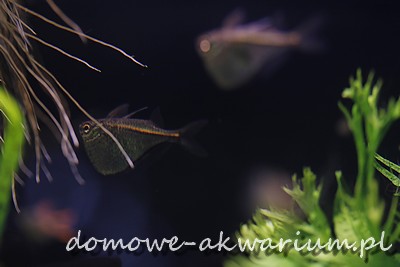
| Species | Blackwing Hatchetfish |
|---|---|
| Other names | Marthae Hatchetfish |
| Latin Name | Carnegiella Marthae |
| Family | salmonids |
| Origin | Ameryka Południowa |
| Length | 3 - 4 cm |
| Temperature | 23 - 27°C |
| Water Hardness | soft - medium hard |
| pH | 5,5 - 7,0 |
| Aquarium Size | 40 L |
| Food | gatunek mięsożerny |
Blackwing Hatchetfish, Marthae Hatchetfish, Blackwinged Hatchetfish
A freshwater species that, under natural conditions, inhabits black waters (blackwater) of Rio Negro and Orinoco, their tributaries, and floodplains formed during the rainy season. These are waters with a thick layer of forest litter (leaves, branches, fruits, cones, nuts, etc.) and dense vegetation covering the water surface.
The species is distinguished by a strongly laterally flattened body of a characteristic shape. The color of the fish is silvery-olive, with delicate darker spots covering the whole body. Along the sides, there are two thin stripes: cream-gold and black. Along the belly (from the head to the base of the tail fin) a black margin can be observed. The fins are transparent. This species is often confused with Carnegiella schereri and Carnegiella myersi. The former is slightly smaller than the species described, the latter is much smaller and has a slightly different body line shape (abdomen) - more straight (less rounded) compared to the small hatchetfish. Sexual dimorphism does not really occur. The female may be slightly thicker in the abdominal areas and during spawning white eggs can be seen in her body.
A naturally shy and calm fish, which almost motionlessly floats among the roots of floating plants. It's a schooling fish - it feels best in a larger group, at least 6 individuals. It can be kept in a community aquarium with peaceful (less active) fish, of similar or smaller size, e.g.: other characins, tetras, carp-like, corydoras, armored catfish or even dwarf cichlids of the genus Apistogramma.

The small hatchetfish prefers aquariums with water tinted to a tea color with the addition of round stones, roots, branches and a layer of litter on the bottom (dried leaves, dried cones, etc.) and free spaces for swimming. The addition of floating vegetation seems to be necessary. Fish can also be kept in clear water, in an aquarium heavily planted with plants. The light should then be moderate and diffused, water movement - minimal. The water in the container must be chemically mature - fish are very delicate and sensitive to any sudden changes in water parameters. A tight cover for the aquarium is essential.
This species is oviparous. Breeding in aquarium conditions is very difficult. Fish are bred in a separate aquarium with very soft water and floating vegetation (necessary hanging roots). The female lays eggs in batches among the floating vegetation. After spawning the parents should be removed. The larvae hatch after about 1-1.5 days and freely swim after another 5 days.